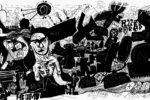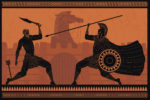Homo Conflictus: The Protean Nature of Armed Violence in a Fragmenting World
This introduction reflects on the changing nature of violent conflict in the 21st century and new grammars of war that are in the making. Conventional wars are in marked decline as armed conflicts are becoming ever more complex, de-structured and unpredictable.
Violence is intrinsic to human life. Already Heraclitus, writing in the 5th century BC, was convinced that “conflict [polemos] is the father of all things and the king of all things”. Etymologically, the Latin violare signifies “to transgress” or “to profane”. In a sense, violence is thus only the most extreme form of conflict resolution, as most conflicts end without recourse to violence.
Of individual and collective violence
The excess potential or surplus energy inherent to violence is, however, not necessarily purely destructive as it also plays a pivotal role in human autonomy, emancipation and free will. Philosophers have long insisted on the plasticity and ubiquity of violence. Birth is violent as it marks the separation of the newborn from its mother through the severing of the umbilical cord. Heidegger’s Geworfenheit implies an existential founding act of violence that is only superseded by death, perhaps the ultimate form of violence. Philosophers have also described violence as a longing for ontological wholeness and a will to unrestricted might as humans grapple to come to terms with their finitude. Freud, for instance, has identified a death instinct in humans, amounting to a fundamental urge of aggression and self-destruction. Ethology has distinguished several biological functions of aggression on the intraspecies level, including “spacing out”, differential reproduction, and hierarchisation.
Violence is polymorphous. It may be physical or verbal, lethal or nonlethal, individual or collective, gendered or nongendered, intentional or accidental, pre-emptive or reactive, political or apolitical, legitimate or illegitimate, pathological or rational. Violence can range from the insidious, diffuse and symbolic (as in structural violence) to the explicit, gruesome and spectacular (as in beheadings, genocide, torture or terrorist attacks). It has been suggested that even persuasion or seduction are but subtle forms of violence.
Violence plays an essential role in the funding, maintenance, evolution and overthrow of societies. Foundational violence is at the core of most societies as suggested by myths of origin such as the ones of Abel and Cain and Romulus and Remus. Violence may serve to enforce societal cohesion and homogeneity as in the form of schoolyard bullying or, conversely, prove liberating or cathartic as in revolutions. Violence is culturally constructed, invested with multiple meanings and identity formative. Different cultures conceive of and tolerate violence differently. "Violent practices" need "violent imaginaries" or "repertoires of violence" as a source of inspiration.
History has been marked by collective violence directed at outgroups. Over time, the art of war making underwent a series of paradigmatic changes, closely linked to technological innovations such as the invention of gunpowder, stirrups or airplanes. Military historians have thus distinguished between a series of distinct epochs such as the age of chariots; the age of infantry; the age of cavalry; the age of muskets; and the age of industrial warfare. While, historically, violence has been largely tamed at the state level (through the monopoly of violence) the same cannot be said at the international level where anarchy – and thus the law of the strongest – has prevailed for most of the modern era.
The Enlightenment narrative and its paradox
For over 70 years now, however, the world has benefitted from the so-called “long peace”: i.e., the absence of major wars between great powers, often attributed to the Cold War–inherited paradigm of mutually assured destruction (MAD). According to social psychologist Steven Pinker, however, this era of relative peace also reflects a more secular trend away from violence rooted in civilising processes. Many indicators of violence – murder, rape, child abuse, wife battering – have indeed declined, some massively so, in the longue durée. According to Pinker, “violent deaths of all kinds have declined, in relative terms, from around 500 per 100,000 people per year in prestate societies to around 50 in the Middle Ages, to 6–8 today worldwide, and fewer than 1 in most of Europe”. Current conflicts – including acts of global terror –, Pinker further insists, are mostly sideshows when compared to the major conventional wars fought in the 20th century or the ingrained violence of most archaic societies.
The 1990s were nevertheless marked by a flurry of new conflicts brought about by the end of the Cold War. As a result, Western powers have become accustomed to projecting power to trouble spots around the world. Since the fateful attacks of 11 September 2001 and the US subsequent global war on terror, the international system has been marked by tension and fragmentation. While the number of armed conflicts has constantly fluctuated between 30 and 52 from 2003 to 2013, it has witnessed an upward trend in recent years. We are thus facing a paradox: while interpersonal violence has come down to historical lows, old conflicts persist and new ones continue to flourish – mostly so in sub-Saharan Africa and the Middle East.
New Wars in the 21st century?
Contemporary conflicts are characterised by a dramatic multiplication of actors and the lack of clear contours between local, national and international as well as between combatant and noncombatant entities. Accordingly, Mary Kaldor has introduced the notion of new wars, suggesting that while old wars were typically fought between states “for geopolitical interests or for ideology”, new wars “are fought by varying combinations of networks of state and nonstate actors – regular armed forces, private security contractors, mercenaries, jihadists, warlords, paramilitaries, etc. […] in the name of identity (ethnic, religious or tribal)” and greed. New wars can henceforth be described as a mixture of war, crime, and human rights violations; they give rise to a political economy of violence that is at the antipodes of any ethical code.
Classic interstate conflict – based on the Clausewitzian conception of war as a duel between states’ clashing political wills – has all but disappeared. New wars are mostly civil wars – often resulting from the fragilisation of states or entire regions – that may spill across regional borders (Boko Haram, Sahel) or compel varying degrees of, often covert, international interventions. To complexify this internationalisation of civil conflict, the very texture of the international system has changed as the myriad of nonstate armed actors involved in these conflicts also take advantage of the asymmetric opportunities offered by globalisation: by mobilising transitional networks (including financially); waging global communication campaigns to spread fear or recruit combatants; or causing havoc among the global public through indiscriminate terrorist attacks.
States have reacted to this new situation by adopting more agile – often covert – operational strategies. They have reverted to surrogate warfare relying on proxies, deniable operations, drones, airpower and cyberweapons, thereby “externalis[ing] the burden of warfare”. Over 6,500 private military and security companies are now selling a wide range of services, including advising, armed protection, technical support, military training, intelligence, cybersecurity and combat operations. These “corporate warriors” have, however, been criticised for their purely commercial stake in warfare and their questionable human rights record.
New wars are mostly civil wars that may spill across regional borders (Boko Haram, Sahel) or compel varying degrees of, often covert, international interventions. Civilians have been the major victims of conflict in the 21st century. The growing urbanisation of conflicts has further exacerbated their vulnerability, exposing them to aerial bombings, explosives in urban guerrilla warfare, and coercion from competing armed groups. Civilians are frequently targeted deliberately by nonstate armed groups such as Boko Haram and pay a high toll to the brutalisation of conflicts such as those in Syria, Yemen, the Democratic Republic of the Congo or South Sudan. Finally, armed conflicts are the major cause behind the 68.5 million people forcibly displaced in 2017. Given their extreme dependence, migrants and internally displaced persons are easy targets of violence, enduring systematic racket, extortion, rape and gratuitous violence both in the camps and during their journeys toward safer places.
Uncertain futures
The new war narrative, however, remains contested and uncertainty prevails as to what armed conflicts may look like in the future. War and peace have become increasingly blurred. Many armed conflicts are now of a protracted nature, alternating bursts of violent outbreaks with prolonged periods of low intensity or dormancy. Other conflicts have endured or even intensified after the signing of official truces or peace agreements. Furthermore, a majority of interpersonal violence nowadays occurs outside the frames of clearly defined conflicts in societies pervasively impregnated by violence such as the Mexican. According to the Small Arms Survey, in 2016 interpersonal and collective violence claimed the lives of 560,000 people worldwide, of which 385,000 were the victims of intentional homicides and only 99,000 were casualties of war.The 99,000 war related casualties globally identified by the Small Arms Survey for 2016 indeed make a pale figure when compared to the estimated over 55 million who died in the Second World War Of the five countries with the highest violent death rates in 2016 – Syria, El Salvador, Venezuela, Honduras and Afghanistan – only two had active armed conflicts.
Technological advances – in the field of unmanned systems, robotics, data processing, artificial intelligence (AI), nanotechnology and synthetic biology – will further transform warfare in ways that remain still largely unpredictable. The future may also see warfare expand to new places such as outer space, the deep oceans or the Arctic. Space, in particular, has become crucial for modern warfare as satellites – of which there are now over 1,300 on orbit – are essential to GPS, communications and digital imagery. Cyberwars and digital hacking may allow to deal major blows to enemies through blackouts in power grids or other crucial public infrastructure.
These new military technologies are not without risks. Robots are no smarter than the people who programme them, replicating the same prejudices but without the possibility to reflect on them. Errors in design may expose killer robots to hacking and untoward choices, given their lack of understanding of context and ambiguity. The anonymisation of decision-making may lead to a “vacuum of moral responsibility”, as suggested by the ludicrous possibility of an international humanitarian law for robots. AI-enhanced weapons may lead to escalation and proliferation and reinforce existing asymmetries, given their prohibitive cost. Whatever the future developments of such military technologies, boots on the ground and close-combat units are likely remain crucial in most types of conflicts.
The present dossier explores new trends and expressions of violence in armed conflict in the 21st century. It analyses the heterogeneity, asymmetries, scales and vectors of violent practices and assesses the impact of factors such as military technologies, sexual violence, gangs’ criminality, attacks on humanitarians, urban warfare, or the privatisation of security.
-
1
 On (Political) Violence
On (Political) ViolenceWestern military interventions in Afghanistan and Iraq, hybrid warfare in eastern Ukraine, terrorist attacks in Europe, civil war in Syria, or armed militias in the eastern Democratic Republic of the Congo – all seem to portray a world of ever-greater danger. Yet just how violent are contemporary global politics, and how – if at all – have armed conflict and political violence changed since the end of the Cold War? By Keith Krause.
-
2
 What Is Really New about the New Wars?
What Is Really New about the New Wars?A historical glance at the armed conflicts of the last thirty years shows that war, in its essence, has not changed. Novelty lies rather in the materialisation of distinct stylistic features and the addition of previously absent layers and perspectives. By Mohammad-Mahmoud Ould Mohamedou.
-
3
 The Privatisation of War
The Privatisation of WarPrivate military and security companies (PMSCs) have been booming since the end of the Cold War. Are they the mercenaries of the 21st century? What are the risks and benefits of this privatisation of war? By Annyssa Bellal.
-
4
 Welcome to the World of Killer Robots
Welcome to the World of Killer RobotsAlthough cyborg assassins won’t be arriving from the future anytime soon, offensive “Terminator-style” autonomous robots that are programmed to kill could soon escape Hollywood science fiction and become reality. This actual rise of the machines raises important strategic, moral, and legal questions about whether the international community should empower robots to kill, and if so, what could be the consequences and how to regulate them. By Denise Garcia.
-
5
 Sexual Violence: A New Weapon of War?
Sexual Violence: A New Weapon of War?Sexual violence in war is now being recognised in international law, policies, and scholarship. This new visibility has inadvertently normalised it as a standard weapon of war, which raises problematic issues ultimately questioning the distinction between war and peace. By Elisabeth Prügl.
-
6
 The Morphology of Urban Conflict
The Morphology of Urban ConflictDestabilised by the massive influx of migrants, breeding grounds for conflict and dispossession, and characterised by the formation of group enclaves and fractured spaces, cities constitute the primary locale for the majority of the world’s population. As the locus of armed conflict shifts to urban areas, we argue that these events will be more frequent and intractable, increasingly difficult to comprehend, and vastly more destructive. By Ravi Bhavnani and Mirko Reul.
-
7
![Émile Friant's drawing of Marie Marvingt and her proposed air ambulance. Émile Friant [Public domain], via Wikimedia Commons](https://globalchallenges.ch/wp-content/uploads/2019/03/Marie_Marvingt_by_Emile_Friant_1914-150x100.jpg) Humanitarians as Targets of Violence?
Humanitarians as Targets of Violence?Recent years have seen an increased focus on acts of violence and attacks perpetrated against humanitarian actors. Who is attacking them, why and in what circumstances? Does this surge in violence constitute a radical break in the way humanitarians are perceived and treated, or is it a longstanding phenomenon that has been inflated by its treatment in the media? By Gilles Carbonnier.
-
8
 The Fog of Crime: Gang Transformation and the Unpredictability of Violence in Central America
The Fog of Crime: Gang Transformation and the Unpredictability of Violence in Central AmericaIn post–Cold War Central America, chronic criminal violence, most commonly perpetrated by gangs, has replaced guerrilla wars and dictatorial repression. Gangs are highly volatile and, as such, their criminal governance is marked by unpredictability. This “fog of crime” has far more pernicious consequences for the population than past forms of violence. By Dennis Rodgers.
-
O
 Reflections on the Future of Violent Conflict
Reflections on the Future of Violent ConflictConflict studies are as old as humanity itself. Yet there continues to be a need for further reflection as the conditions under which violence manifests itself change over time. We close this dossier with a few observations to invite further debate. By Oliver Jütersonke
Map based on the data produced by the Small Arm Survey, and enriched by the Graduate Institute's Research Office in Geneva, in collaboration with whybe.ch.
State-Based Conflict since 1946
© ourworldindata.org / CC - Creative Commons
Source: Uppsala Conflict Data Program (UCDP)
Variable description: Ongoing conflicts are represented in each year in which more than 25 deaths occurred.
Terminology Related to Violence and Conflict
The intentional use of physical force or power, threatened or actual, against oneself, another person, or against a group or community, that either results in or has a high likelihood of resulting in injury, death, psychological harm, maldevelopment, or deprivation.
The World Health Organization (WHO)
Derived from the Latin word conflictus, which means collision or clash. This term is understood as a disagreement between two or more parties through which the parties involved perceive a threat to their needs, interests or concerns. Source
A dispute involving the use of armed force between two or more parties, often referred to as war. Source
Militarised armed conflict between two or more states. Source
A conflict between a government and one or several non-governmental parties, often with interference or support from foreign actors.
The intentional use of illegitimate force (actual or threatened) with arms or explosives, against a person, group, community, or state that undermines people-centred security and/or sustainable development. Source
Violence that is directed against a person on the basis of gender or sex. It includes acts that inflict physical, mental, or sexual harm or suffering, threats of such acts, coercion, or other deprivations of liberty. While women, men, boys and girls can be victims of gender-based violence, because of their subordinate status, women and girls are the primary victims. Source
IHL distinguishes between Non-international armed conflict defined as "A conflict in which government forces are fighting with armed insurgents, or armed groups are fighting amongst themselves" and International armed conflict defined as "A war involving two or more States, regardless of whether a declaration of war has been made or whether the parties recognize that there is a state of war. Source
A criminal act or acts intended to inflict dramatic and deadly injury on civilians and to create an atmosphere of fear, generally in furtherance of a political or ideological (whether secular or religious) purpose. Terrorism is most often carried out by sub-national or transnational groups, but it has also been known to be practiced by rulers as an instrument of control. Source
Research Office

